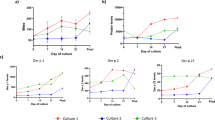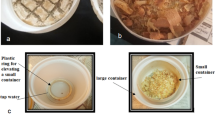Abstract
The house dust mites, Dermatophagoides pteronyssinus and D. farinae are cultured commercially and in research laboratories and material is harvested from these cultures to make extracts that are used for diagnosis, immunotherapy and research. Temperature and other climatic conditions can influence population growth rates, dynamics of allergen production, and the associated endotoxin, enzyme and protein levels of the mite material harvested from these cultures. Here we determined how temperature affected these parameters. Dermatophagoides pteronyssinus was cultured at 20 and 25°C at 75% relative humidity, and at 2-week intervals the concentrations of mites, Der p 1 and Der p 2 allergens, endotoxin, and selected enzymes were determined. Mite density increased exponentially but growth rate and final population density were greater at 25°C compared to 20°C. The combined allergen (Der p 1 + Der p 2) concentrations accumulated in the cultures at about the same rate at both temperatures. However, individual Der p 1 and Der p 2 accumulation rates varied independently at the two temperatures. Der p 1 accumulated faster at 20°C whereas Der p 2 accumulated faster at 25°C. The amount of Der p 1 in whole cultures was greater than the amount of Der p 2. The concentration of allergen for washed mites harvested from the cultures was much less than for the whole cultures. Our study demonstrated that temperature is an important factor in population growth and the dynamics of allergen production in cultured mites.





Similar content being viewed by others
References
Andersen A (1988) Population growth and developmental stages of the house dust mite, Dermatophagoides pteronyssinus (Acari: Pyroglyphidae). J Med Entomol 25:370–373
Arbes SJ Jr, Gergen PJ, Elliott L, Zeldin DC (2005) Prevalences of positive skin test responses to 10 common allergens in the US population: results from the third National Health and Nutrition Examination Survey. J Allergy Clin Immunol 116:377–383
Arlian LG, Dippold JS (1996) Development and fecundity of Dermatophagoides farinae (Acari: Pyroglyphidae). J Med Entomol 33:257–260
Arlian LG, Bernstein IL, Gallagher JS (1982) The prevalence of house dust mites, Dermatophagoides spp, and associated environmental conditions in homes in Ohio. J Allergy Clin Immunol 69:527–532
Arlian LG, Woodford PJ, Bernstein IL, Gallagher JS (1983) Seasonal population structure of house dust mites, Dermatophagoides SPP. (Acari: Pyroglyphidae). J Med Entomol 20:99–102
Arlian LG, Geis DP, Vyszenski-Moher DL, Bernstein IL, Gallagher JS (1984) Cross antigenic and allergenic properties of the house dust mite Dermatophagoides farinae and the storage mite Tyrophagus putrescentiae. J Allergy Clin Immunol 74:172–179
Arlian LG, Rapp CM, Ahmed SG (1990) Development of Dermatophagoides pteronyssinus (Acari: Pyroglyphidae). J Med Entomol 27:1035–1040
Arlian LG, Bernstein D, Bernstein IL, Friedman S, Grant A, Lieberman P, Lopez M, Metzger J, Platts-Mills T, Schatz M (1992) Prevalence of dust mites in the homes of people with asthma living in eight different geographic areas of the United States. J Allergy Clin Immunol 90:292–300
Arlian LG, Confer PD, Rapp CM, Vyszenski-Moher DL, Chang JC (1998) Population dynamics of the house dust mites Dermatophagoides farinae, D. pteronyssinus, and Euroglyphus maynei (Acari: Pyroglyphidae) at specific relative humidities. J Med Entomol 35:46–53
Arlian LG, Neal JS, Morgan MS, Vyszenski-Moher DL, Rapp CM, Alexander AK (2001) Reducing relative humidity is a practical way to control dust mites and their allergens in homes in temperate climates. J Allergy Clin Immunol 107:99–104
Arlian LG, Morgan MS, Peterson KT (2008) House dust and storage mite extracts influence skin keratinocyte and fibroblast function. Int Arch Allergy Immunol 145:33–42
Arlian LG, Elder BL, Morgan MS (2009) House dust mite extracts activate cultured human dermal endothelial cells to express adhesion molecules and secrete cytokines. J Med Entomol 46:595–604
Arshad SH (2003) Indoor allergen exposure in the development of allergy and asthma. Curr Allergy Asthma Rep 3:115–120
Batard T, Hrabina A, Bi XZ, Chabre H, Lemoine P, Couret MN, Faccenda D, Villet B, Harzic P, Andre F, Goh SY, Andre C, Chew FT, Moingeon P (2006) Production and proteomic characterization of pharmaceutical-grade Dermatophagoides pteronyssinus and Dermatophagoides farinae extracts for allergy vaccines. Int Arch Allergy Immunol 140:295–305
Calvo M, Fernandez-Caldas E, Arellano P, Marin F, Carnes J, Hormaechea A (2005) Mite allergen exposure, sensitisation and clinical symptoms in Valdivia, Chile. J Investig Allergol Clin Immunol 15:189–196
Cardona G, Guisantes J, Eraso E, Serna LA, Martinez J (2006) Enzymatic analysis of Blomia tropicalis and Blomia kulagini (Acari: Echimyopodidae) allergenic extracts obtained from different phases of culture growth. Exp Appl Acarol 39:281–288
Carswell F, Oliver J, Weeks J (1999) Do mite avoidance measures affect mite and cat airborne allergens? Clin Exp Allergy 29:193–200
Chen HL, Su HJ, Lin LL (2002) Distribution variations of multi allergens at asthmatic children’s homes. Sci Total Environ 289:249–254
Cook DN, Pisetsky DS, Schwartz DA (2004) Toll-like receptors in the pathogenesis of human disease. Nat Immunol 5:975–979
Elias JA, Homer RJ, Hamid Q, Lee CG (2005) Chitinases and chitinase-like proteins in T(H)2 inflammation and asthma. J Allergy Clin Immunol 116:497–500
Eraso E, Guisantes JA, Martinez J, Saenz-de-Santamaria M, Martinez A, Palacios R, Cisterna R (1997) Kinetics of allergen expression in cultures of house dust mites, Dermatophagoides pteronyssinus and D. farinae (Acari: Pyroglyphidae). J Med Entomol 34:684–689
Eraso E, Martinez J, Garcia-Ortega P, Martinez A, Palacios R, Cisterna R, Guisantes JA (1998) Influence of mite growth culture phases on the biological standardization of allergenic extracts. J Investig Allergol Clin Immunol 8:201–206
Finkelman MA, Lempitski SJ, Slater JE (2006) β-Glucans in standardized allergen extracts. J Endotoxin Res 12:241–245
Kaisho T, Akira S (2006) Toll-like receptor function and signaling. J Allergy Clin Immunol 117:979–987
Lang JD, Mulla MS (1978) Seasonal dynamics of house dust mites. Dermatophagoides spp., in homes in southern California. Environ Entomol 7:281–286
Martinez J, Eraso E, Palacios R, Guisantes JA (2000) Cross-reactions between Dermatophagoides pteronyssinus and Dermatophagoides farinae (Acari: Pyroglyphidae) related to the different growth phases of cultures. J Med Entomol 37:35–39
Mascia F, Mariani V, Giannetti A, Girolomoni G, Pastore S (2002) House dust mite allergen exerts no direct proinflammatory effects on human keratinocytes. J Allergy Clin Immunol 109:532–538
Morgan MS, Arlian LG (2006) Enzymatic activity in extracts of allergy-causing astigmatid mites. J Med Entomol 43:1200–1207
Osterberg M, Lehmann-Olsson B, Larsson A (2007) Development of mite allergen source material—the dynamics of Der p 1 and Der p 2 content in purified Dermatophagoides pteronyssinus during cultivation. Allergy 62:561–562
Ovsyannikova IG, Vailes LD, Li Y, Heymann PW, Chapman MD (1994) Monoclonal antibodies to group II Dermatophagoides spp. allergens: murine immune response, epitope analysis, and development of a two-site ELISA. J Allergy Clin Immunol 94:537–546
Slater JE, Paupore EJ, Elwell MR, Truscott W (1998) Lipopolysaccharide augments IgG and IgE responses of mice to the latex allergen Hev b 5. J Allergy Clin Immunol 102:977–983
Su HJ, Wu PC, Chen HL, Lee FC, Lin LL (2001) Exposure assessment of indoor allergens, endotoxin, and airborne fungi for homes in southern Taiwan. Environ Res 85:135–144
Thomas WR, Heinrich TK, Smith WA, Hales BJ (2007) Pyroglyphid house dust mite allergens. Protein Pept Lett 14:943–953
Topp R, Wimmer K, Fahlbusch B, Bischof W, Richter K, Wichmann HE, Heinrich J, INGA study group (2003) Repeated measurements of allergens and endotoxin in settled house dust over a time period of 6 years. Clin Exp Allergy 33:1659–1666
Trivedi B, Valerio C, Slater JE (2003) Endotoxin content of standardized allergen vaccines. J Allergy Clin Immunol 111:777–783
Tsay A, Williams L, Mitchell EB, Chapman MD, Multi-Centre Study Group (2002) A rapid test for detection of mite allergens in homes. Clin Exp Allergy 32:1596–1601
Valerio CR, Murray P, Arlian LG, Slater JE (2005) Bacterial 16S ribosomal DNA in house dust mite cultures. J Allergy Clin Immunol 116:1296–1300
van Ree R (2007) Indoor allergens: relevance of major allergen measurements and standardization. J Allergy Clin Immunol 119:270–277
van Ree R, Chapman MD, Ferreira F, Vieths S, Bryan D, Cromwell O, Villalba M, Durham SR, Becker WM, Aalbers M, Andre C, Barber D, Cistero Bahima A, Custovic A, Didierlaurent A, Dolman C, Dorpema JW, Di Felice G, Eberhardt F, Fernandez Caldas E et al (2008) The CREATE project: development of certified reference materials for allergenic products and validation of methods for their quantification. Allergy 63:310–326
Wan H, Winton HL, Soeller C, Tovey ER, Gruenert DC, Thompson PJ, Stewart GA, Taylor GW, Garrod DR, Cannell MB, Robinson C (1999) Der p 1 facilitates transepithelial allergen delivery by disruption of tight junctions. J Clin Invest 104:123–133
Wills-Karp M, Karp CL (2004) Chitin checking–novel insights into asthma. N Engl J Med 351:1455–1457
Winton HL, Wan H, Cannell MB, Thompson PJ, Garrod DR, Stewart GA, Robinson C (1998) Class specific inhibition of house dust mite proteinases which cleave cell adhesion, induce cell death and which increase the permeability of lung epithelium. Br J Pharmacol 124:1048–1059
Author information
Authors and Affiliations
Corresponding author
Rights and permissions
About this article
Cite this article
Yella, L., Morgan, M.S. & Arlian, L.G. Population growth and allergen accumulation of Dermatophagoides pteronyssinus cultured at 20 and 25°C. Exp Appl Acarol 53, 103–119 (2011). https://doi.org/10.1007/s10493-010-9394-4
Received:
Accepted:
Published:
Issue Date:
DOI: https://doi.org/10.1007/s10493-010-9394-4




